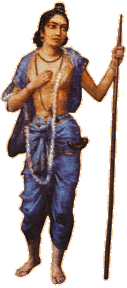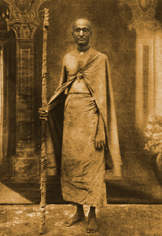
 Devotee: It has been stated by some persons who claim to follow the pure line of devotion presented by Srila Prabhupada Sarasvati Thakura, that Sri Nityananda Prabhu was a sannyasi who later gave up His sannyasa and married the two daughters of Surya Vipra. Is this a fact?
Devotee: It has been stated by some persons who claim to follow the pure line of devotion presented by Srila Prabhupada Sarasvati Thakura, that Sri Nityananda Prabhu was a sannyasi who later gave up His sannyasa and married the two daughters of Surya Vipra. Is this a fact?
Narasingha Maharaja: No, this is not a fact. This is an idea that is commonly put forth by the sahajiya and babaji communities, but it is not so. This concocted idea has not been accepted by Srila Sarasvati Thakura or his followers. One who says that Sri Nityananda Prabhu gave up sannyasa is an offender to the Supreme Lord. At least it must be concluded that such a person is a victim of a poor fund of knowledge.
An attempt has been made to substantiate that Sri Nityananda Prabhu was formerly a sannyasi by quoting from Srila Vrndavana Dasa Thakura's Sri Caitanya-bhagavata, wherein the following verses are found.
kothaya thakila danda kotha kamandalu
kotha va vasana gela nahi adi-mula
Where was His danda, where was His water-pot, and where were His clothes? Nothing remained with Him.
(CB. Madhya 5.62)
katho ratre nityananda hunkara kariya
nija-danda-kamandalu phelila bhangiya
In the dead of night, Nityananda suddenly roared loudly and broke His danda and water-pot.
(CB. Madhya 5.67)
The references here to danda and kamandalu are enough to convince the sahajiyas that Sri Nityananda Prabhu was previously an initiated sannyasi. Some sahajiyas are even of the opinion that Sri Nityananda Prabhu was a sannyasi-disciple of Sri Laksmipati Tirtha, but there is no evidence for this whatsoever. In this regard, Srila Sarasvati Thakura has stated in his purports to the above verses that the danda and kamandalu are not only symbols of the sannyasa-asrama, they are also used by brahmacaris. The brahmacari danda is made from either khadira, palasa or bamboo and when an upakurvana-brahmacari decides to enter householder life, he discards the danda. This is exactly what Lord Nityananda did.
Some persons are of the opinion that Sri Nityananda Prabhu held the sannyasa title Ananda, but according to the Sattvata-samhita, Ananda is not one of the 108 names of a sannyasi. Ananda is sometimes used by the Advaitin section as a name (such as Prakasananda, Svarupananda, Brahmananda etc), but their actual sannyasa title is one of the dasa-nami; Tirtha, Asrama, Vana, Aranya, Parvata, Giri, Sagara, Sarasvati, Bharati and Puri.
Further evidence to suggest that Sri Nityananda Prabhu was a brahmacari and not a sannyasi is given in Srila Sarasvati Thakura's commentary to verse 9 of the fifth chapter in the Madhya-khanda of Caitanya-bhagavata as follows:
Jagad-guru Sri Nityananda Prabhu was a brahmcari disciple of Parivrajakacarya Sri Laksmipati Tirtha, who enacted the pastimes of subordination to the Sri Madhva sampradaya. We find His brahmacari name was Sri Nityananda Svarupa. From ancient times brahmacari disciples of Tirtha and Asrama sannyasis have been addressed as Svarupa.
Again, Srila Prabhupada Sarasvati Thakura writes:
The brahmacari name of Nityananda Prabhu was Svarupa. Since Svarupa is the brahmacari name of a Tirtha sannyasi's disciple, some people consider Him to be a follower of Laksmipati Tirtha rather than a follower of Madhavendra Puri. (Purport to CB. Madhya 5.67)
The revered Guardian of Devotion Om Visnupada Srimad Bhakti Raksaka Sridhara Deva Gosvami Maharaja has commented on this topic thus.
Nityananda was not a sannyasi, he was a brahmacari. He performed Vyasa-puja in Srivasa Angana. There some say that He was a sannyasi, but there He had no special garment either for sannyasi or brahmacari. He was a very independent spirit. (81.09.23)
That Nityananda was a sannyasi, it is not a proven fact. The Nityananda, this is Ananda, this indicates the affix added to brahmacari. Ananda, Svarupa, Prakasa, all these types of brahmacari. Ananda, a name also in the sannyasi we find, but no other title. Ananda is a part of the name but title, no title of Nityananda. And also no mention who was the sannyasa-guru of Nityananda. But diksa-guru of Nityananda is Madhavendra Puri, it is known. Avadhuta does not mean who is sannyasi. Avadhuta means who is not very particular of his external practices and sometimes commits something wrong which should not be committed, should not be practiced. When lower practices are seen in connection with the high-leveled person then they are considered as avadhuta. He is above that but his practices are of lower nature. Ava means lower; dhuta - that also he can either remove or he can purify. (82.02.06)
Furthermore, Srila Vrndavana Dasa Thakura himself is of the opinion that Nityananda was not a sannyasi and has written:
kiba yati nityananda kiba bhakta jnani
ya'ra yena mata iccha na bolaye keni
Some may consider Nityananda to be a sannyasi. Others may consider Him to be a devotee or a jnani. They may say whatever they like. (CB. Adi 9.223)
Another so-called evidence that the sahajiyas present to establish their concocted idea that Sri Nityananda Prabhu took sannyasa is found in Caitanya-bhagavata, Madhya 13.15. 19:
ajna sire kari nityananda-haridasa
tataksane calilena pathe asi hasa
dohana sannyasi-vesa-yana yara ghare
athevyathe asi bhiksa-nimatrana kare
Taking the order of Sri Caitanya upon their heads, Nityananda and Haridasa immediately went out, laughing together in a happy mood. Wherever they went to beg, the householders would extend invitations to them as they were both dressed in the robes of sannyasis.
If we are to take it that the above verse proves that Nitai was a sannyasi, then following such logic we must also believe that Thakura Haridasa was a sannyasi! Actually neither were sannyasis.
Due to the social etiquette of that time, it would have been unthinkable for a Muslim such as Haridasa to take the vows of sannyasa since only those born in brahmana families could formally take to the formal renounced order of life. Simply because they were dressed as mendicants does not necessarily mean that they had actually accepted sannyasa. This type of unorthodox behavior was common with Sri Nityananda Avadhuta and on that day he had dragged Haridasa Thakura into His plot.
If indeed Sri Nityananda Prabhu had formally taken sannyasa, why is there no mention of such an important event in any Gaudiya literature? Why is there no mention of his sannyasa-guru?
Srila Sarasvati Thakura came to re-establish the system of daivi-varnasrama, in particular to re-introduce tridandi-sannyasa in the Gaudiya line for the purpose of preaching love of God. But those persons who oppose Saraswati Thakura have tried to minimize his contribution by creating false stories to show that even Sri Nityananda Prabhu gave up His sannyasa. One important point that the sahajiyas conveniently overlook is that in order to preach love of God, Sri Caitanyadeva Himself accepted sannyasa.
In order to attain the mercy of Sri Caitanyadeva, one must first beg for the mercy of Sri Nityananda Prabhu. If one's crippled mind, however, concocts imaginary proofs that simply degrade the position of the Sri Nityananda Prabhu then such a person is truly most unfortunate.
POSTSCRIPT: During the time of Sarasvati Thakura, Srimad Bhakti Pradip Tirtha Maharaja wrote in his book 'Acara o Acarya' the following:
'Sri Nityananda Prabhu is Avadhuta Paramahamsa, but inspite of admitting this no one should dare to call him 'vantasi' [a person who has fallen away from sannyasa, 'a vomit-eater'], as this would be only aparadha. This is not teachings/tradition of Mahaprabhu to make a sannyasi as a householder.
To claim that Sriman Mahaprabhu or Nityananda Prabhu were doing some impoper or stupid activities - if someone says like this, then it is clearly seen that such contemptible/vile talks belong to the category of Sahajiya. And all talks about preserving proper order (maryada) by succession of sons from the bodily fathers are also downright contemptible/vile and laughable. This kind of statements produced by Sahajiyas are worthy of non-Vaisnavas. The sampradaya can never be preserved by the householders' order of life (grha-vrata-dharma). 'Advaita-Prakasa' and other such books are thouroughly unauthorized (apramanic, not proved by sastras), opposite to tattva, revealed Truth (tattva-viruddha) and is the literary creation of Sahajiyas.'
